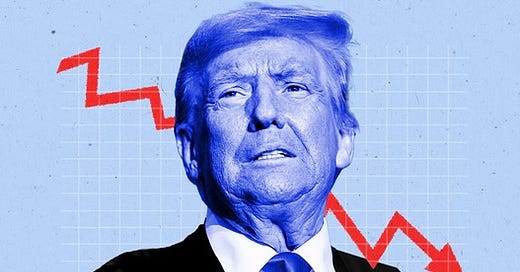Trump's Final Tally Shows Close Win, No Mandate
Trump's vote total has fallen below 50% as the count continues this week, a signal that MAGAland popularity might be less of an issue than it seemed. There's now a 1.68% margin between the candidates.
“An unprecedented and powerful mandate” and a “political victory that our country has never seen before, nothing like this.” That’s how Donald Trump trumpeted his election victory on Nov. 6.
But as the final vote comes in, it seems it’s not quite such a powerful or unprecedented mandate as it first seemed. At the end of the day on Nov. 18, Trump’s vote total sat at 49.94% while Kamala Harris was at 48.26%, according to the authoritative Cook Political Report, which tracks results from official sources in states across the country.
That’s a 1.68% margin, with votes still being counted in heavily Democratic areas on the West Coast.
The Nation, a magazine I’ve been reading off and on since I was a teen, wrote today that only five popular vote winners in history, among the 59 that ran, prevailed with smaller percentage margins than Trump. That means his winning percentage rates as, what, number 54 in history?
Oh my!
Why is this important? It has no effect on Trump winning the election, that’s not in doubt given the absurdity of the Electoral College. But it could give folks in both political parties a feel for how to respond when Trump pulls out the “powerful mandate” and “never seen before” stuff in pushing a gonzo nominee or policy moving forward, particularly with mid-term elections just two short years away.
“Democrats and a handful of thoughtful Republicans have the potential to temper Trump’s worst excesses,” writes John Nichols, the national affairs correspondent for The Nation, “and to assure that the constitutionally mandated system of checks and balances is maintained.”
Additionally, because these numbers are better for Democrats than what we all agonized about on election night, it might help spur early efforts to turn the tables in the 2026 midterms and the 2028 presidential election. The party has struggled to establish a consistently positive profile, often spending more time reacting to shock commentary from the far-right than moving proactively to support the middle class that dominates U.S. voting.
In her Letters from an American commentary this morning, Heather Cox Richardson noted Trump’s “very short coattails in the election,” writing that four Democrats won in states carried by Trump and that “the Republicans have the smallest House majority since there have been 50 states, despite the help their numbers have had from the extreme gerrymandering in states like North Carolina.”
History always was my favorite course in school, and nobody does it better than Heather Cox Richardson.
“Unprecedented” and “never seen before.” This type of phrasing is so Trump. While other winners might rush to thank the people who worked and voted for them, he always seems to make things mostly about himself, and you can pretty much expect him to enlarge anything he’s involved with beyond any reasonable level.
You might recall that this guy insisted the Trump Building at 40 Wall St. in Manhattan was nine floors taller than it actually is in an effort to inflate its value. That, of course, goes to his sometimes passionate, over-the-top lies about crowd sizes and, in the past, his personal wealth.
It takes a while for all votes to be counted in national elections. Most are counted within 24 hours of the polls closing, allowing a winner to be declared. But each state has its own schedule of when election results must be completed and certified in order to accommodate things like ballots sent through the mail or absentee votes from around the world.
On average, according to most accounts, it's taken about two weeks from the general election for all the votes to be counted.
“Let’s put this in perspective,” writes Nichols at The Nation. “Trump is winning a lower percent of the popular vote this year than Biden did in 2020 (51.3), Obama in 2012 (51.1), Obama in 2008 (52.9), George W. Bush in 2004 (50.7), George H.W. Bush in 1988 (53.2), Ronald Reagan in 1984 (58.8), Reagan in 1980 (50.7), or Jimmy Carter in 1976 (50.1).”
And that’s not to mention the folks who won with at least 60% of the vote, including Richard Nixon, Lyndon Johnson and Franklin Delano Roosevelt. So, no, it appears he’s not close to having “a political victory that our country has never seen before.”
We still have votes coming in, but it doesn’t really matter at this point. We’re a nation cut in half now for at least a decade by the likes of Fox News and a multitude of far-right bloggers. We probably can expect any national election to be tight as this one was, despite Trump’s attempt to build it up.
And the closeness of the race may be a signal that MAGAland’s rise may not be as solidly based as it initially seemed.


